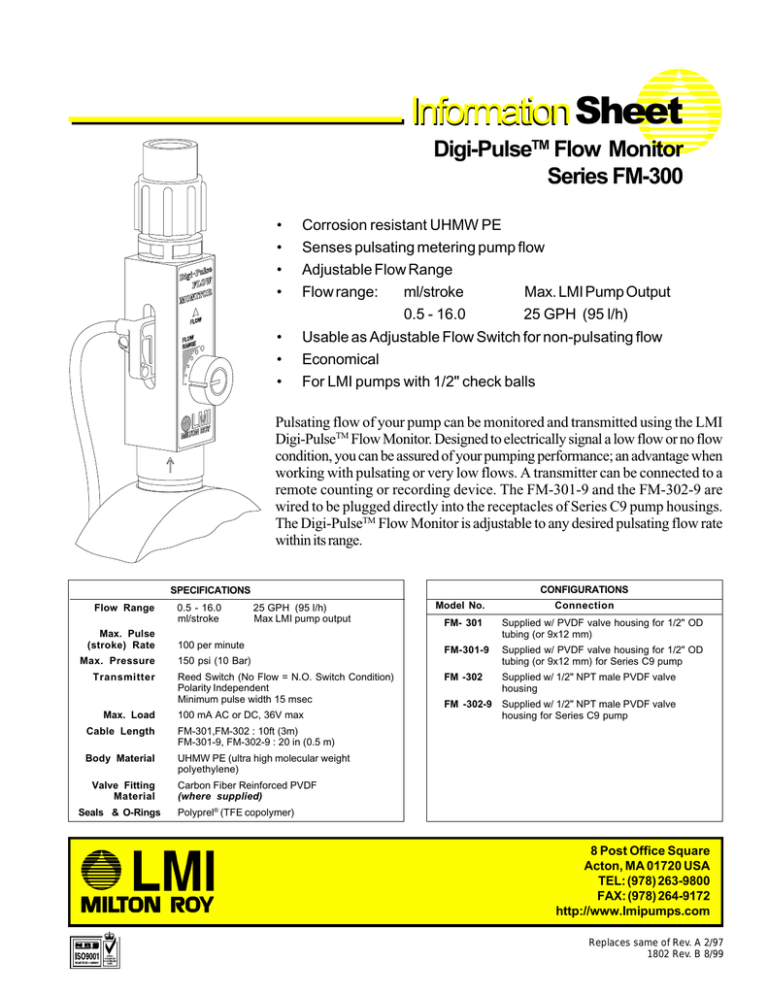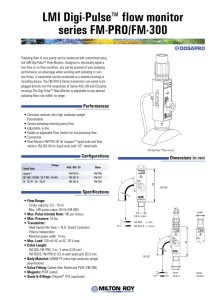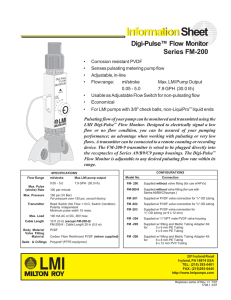
Information Sheet
Digi-PulseTM Flow Monitor
Series FM-300
•
•
•
•
•
•
•
Corrosion resistant UHMW PE
Senses pulsating metering pump flow
Adjustable Flow Range
Flow range:
ml/stroke
Max. LMI Pump Output
0.5 - 16.0
25 GPH (95 l/h)
Usable as Adjustable Flow Switch for non-pulsating flow
Economical
For LMI pumps with 1/2" check balls
Pulsating flow of your pump can be monitored and transmitted using the LMI
Digi-PulseTM Flow Monitor. Designed to electrically signal a low flow or no flow
condition, you can be assured of your pumping performance; an advantage when
working with pulsating or very low flows. A transmitter can be connected to a
remote counting or recording device. The FM-301-9 and the FM-302-9 are
wired to be plugged directly into the receptacles of Series C9 pump housings.
The Digi-PulseTM Flow Monitor is adjustable to any desired pulsating flow rate
within its range.
CONFIGURATIONS
SPECIFICATIONS
Flow Range
Max. Pulse
(stroke) Rate
Max. Pressure
Transmitter
Max. Load
0.5 - 16.0
ml/stroke
25 GPH (95 l/h)
Max LMI pump output
100 per minute
Reed Switch (No Flow = N.O. Switch Condition)
Polarity Independent
Minimum pulse width 15 msec
100 mA AC or DC, 36V max
FM-301,FM-302 : 10ft (3m)
FM-301-9, FM-302-9 : 20 in (0.5 m)
Body Material
UHMW PE (ultra high molecular weight
polyethylene)
Seals & O-Rings
Connection
FM- 301
Supplied w/ PVDF valve housing for 1/2" OD
tubing (or 9x12 mm)
FM-301-9
Supplied w/ PVDF valve housing for 1/2" OD
tubing (or 9x12 mm) for Series C9 pump
FM -302
Supplied w/ 1/2" NPT male PVDF valve
housing
150 psi (10 Bar)
Cable Length
Valve Fitting
Material
Model No.
FM -302-9 Supplied w/ 1/2" NPT male PVDF valve
housing for Series C9 pump
Carbon Fiber Reinforced PVDF
(where supplied)
Polyprel® (TFE copolymer)
8 Post Office Square
Acton, MA 01720 USA
TEL: (978) 263-9800
FAX: (978) 264-9172
http://www.Imipumps.com
Replaces same of Rev. A 2/97
1802 Rev. B 8/99
Instruction Sheet
Digi-Pulse Flow Monitor
Installation
WARNING:
The valve fitting on the discharge portion of the
Digi-PulseTM Flow Monitor must be a flange
type fitting to ensure a proper seal with the ORing. Using a winged type valve fitting will not
create a seal and leakage of solution will
occur.
1. With your pump turned off, screw the lower valve fitting
of the Digi-PulseTM Flow Monitor to the discharge side
of the pump head.
2. Attach tubing to top of valve housing.
3. Connect the Digi-PulseTM cable to your counter, computer, or other recording device (polarity is not critical).
If cable extension is desired, consult factory. Plug the
FM-300-9 Series cable directly into the receptacle in
the Series C9 pump housing.
4. Loosen the locknut of the flow-range knob of the flow
monitor and set the knob to the largest dot. Start the
pump and adjust it (calibrate, if necessary) for proper
output to satisfy your system requirements.
5. With the pump running, gradually turn the adjustment
knob of the flow monitor counter-clockwise until the
sensor just begins to trigger your electronic device.
This will be the most sensitive setting of the Digi-PulseTM
Flow Monitor. Every stroke of the pump will output
enough volume of solution to cause the Digi-PulseTM
flow monitor to register a pulse. If the flow drops below
the initial pump setting, the Digi-PulseTM will no longer
register strokes to your electronics, indicating some type
of pump failure or low-level condition.
6. Tighten the adjustment locknut without altering the
adjustment position.
Note:
After the initial pump and Digi-PulseTM setup is complete, any adjustment of the stroke length of the pump
(output per stroke) will require a readjustment of the
Digi-PulseTM flow monitor (repeat steps 4 - 6 above).
To change the flow range setting:
A set screw holds the transmitter body in a notch on the
side of the flow monitor. Remove the screw and washer
and slide or turn the transmitter 180° to an alternate
position and tighten the screw and washer in the hole to
secure the transmitter. The Digi-PulseTM Flow Monitor
comes factory set at the "LOW" setting which should
accommodate most applications. However, the "INTERMEDIATE" or "HIGH" settings may be
appropriate for a particular application if the sensor does
not trigger in the "LOW" setting.
© 1999 LMI Milton Roy - All Rights Reserved
Printed in USA
Specifications subject to change without notice.








